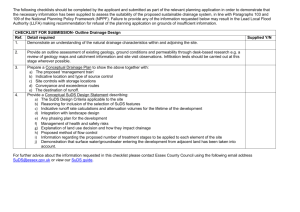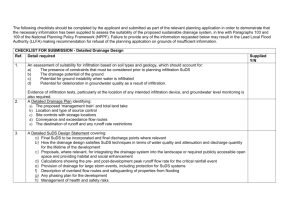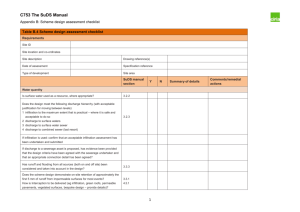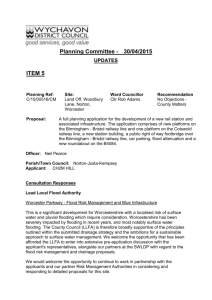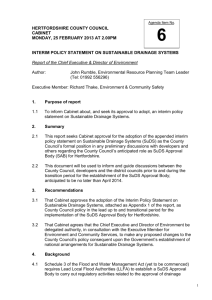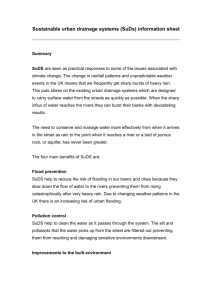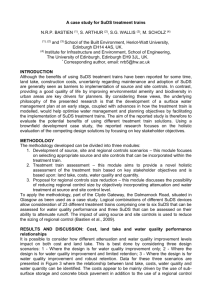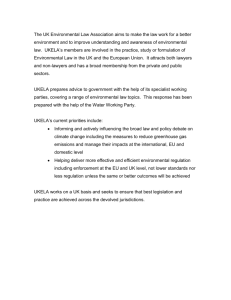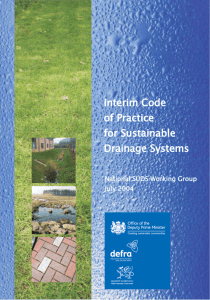the POS response in full (Word format)
advertisement
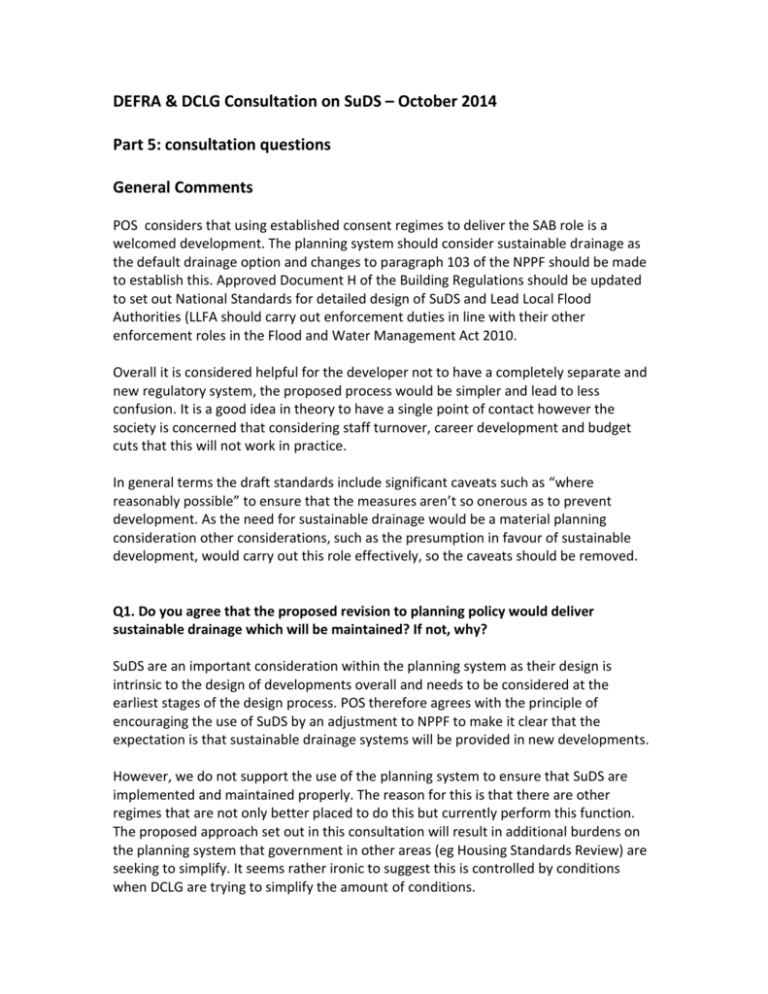
DEFRA & DCLG Consultation on SuDS – October 2014 Part 5: consultation questions General Comments POS considers that using established consent regimes to deliver the SAB role is a welcomed development. The planning system should consider sustainable drainage as the default drainage option and changes to paragraph 103 of the NPPF should be made to establish this. Approved Document H of the Building Regulations should be updated to set out National Standards for detailed design of SuDS and Lead Local Flood Authorities (LLFA should carry out enforcement duties in line with their other enforcement roles in the Flood and Water Management Act 2010. Overall it is considered helpful for the developer not to have a completely separate and new regulatory system, the proposed process would be simpler and lead to less confusion. It is a good idea in theory to have a single point of contact however the society is concerned that considering staff turnover, career development and budget cuts that this will not work in practice. In general terms the draft standards include significant caveats such as “where reasonably possible” to ensure that the measures aren’t so onerous as to prevent development. As the need for sustainable drainage would be a material planning consideration other considerations, such as the presumption in favour of sustainable development, would carry out this role effectively, so the caveats should be removed. Q1. Do you agree that the proposed revision to planning policy would deliver sustainable drainage which will be maintained? If not, why? SuDS are an important consideration within the planning system as their design is intrinsic to the design of developments overall and needs to be considered at the earliest stages of the design process. POS therefore agrees with the principle of encouraging the use of SuDS by an adjustment to NPPF to make it clear that the expectation is that sustainable drainage systems will be provided in new developments. However, we do not support the use of the planning system to ensure that SuDS are implemented and maintained properly. The reason for this is that there are other regimes that are not only better placed to do this but currently perform this function. The proposed approach set out in this consultation will result in additional burdens on the planning system that government in other areas (eg Housing Standards Review) are seeking to simplify. It seems rather ironic to suggest this is controlled by conditions when DCLG are trying to simplify the amount of conditions. Under the Building Regulations (Approved Document H: Drainage and Waste Disposal) new developments have to be properly drained. This Document should be amended to ensure that SuDS are incorporated into the Building Regulations so that their detailed implementation can be checked alongside the implementation of all other functional elements of a building. It is assumed that any SuDS currently being provided as part of a development are checked in this way as the Building Regulations are required to sign off drainage as being in compliance. There is no sensible reason to set up a separate detailed implementation regime through the planning system when one already exists in the Building Regulations. Therefore, in common with many other detailed technical issues, a planning application would establish the principles of what is proposed and the detailed SuDS would need to be in compliance with a planning approval and the revised Building Regulations. Councils have a responsibility under the Flood Management Act for ensuring that drainage and flood management infrastructure are recorded and maintained. This should be the body responsible for enforcing the ongoing effective operation and functioning of SuDS along with the other drainage assets that they are responsible for. To separate out SuDS as being the responsibility of the local planning authority makes no more sense than making them responsible for the maintenance of highways in the context of the powers available to the highway authority. There is no sensible reason to set up a separate enforcement regime through the planning system when one already exists through the Flood Management Act. Detailed consideration needs to be given to fall-back options if a maintenance company, or the other selected maintenance option, fails and an enforcement Order under Schedule 3 of the Flood and Water Management Act should provide for effective action to be taken. Q2. How should the Local Planning Authority obtain expert advice on sustainable drainage systems and their maintenance? What are the costs/benefits of different approaches? As set out above, POS believes that the detailed implementation of SuDS should be through the Building Regulations. Including the National Standards in an amended Approved Document would provide clarity and certainty as to what is required, minimising the need for expert advice. Nevertheless consideration of the SUDS system would need to be given at the planning application stage. It is understood that the Environment Agency is expecting to step back from surface water drainage, as a local flood risk issue. As such, it will be necessary for independent expert advice to be secured by LPAs. The appropriate body should be a statutory consultee, but interdisciplinary knowledge is necessary which will require specialist consultants or members of staff and would constitute a new burden. LPAs do not have this expertise in-house and sourcing specialist advice would lead to budget issues. It could be that the developer bears the cost for this expert advice similar to assessing a basement impact assessment or viability assessment. However this may lead to delays if a developer is reluctant to pay the fees for external expert advice. Alternatively the budget of the statutory consultee would need to be adjusted to provide this service to LPAs; this charge could be levied through increasing planning fees to generate additional resources for statutory consultees. Detailed guidance on standards and methods of calculating run-off, infiltration etc should be included in industry standard best practice which has buy in from major stakeholders, including developers. There should also be a statutory requirement to consult the county council who have statutory duties as Lead Local Flood Authority (LLFA) and where the specialist skills should reside. It may therefore make sense for any regulations/guidance to refer to the need for county councils to be involved where appropriate adding a statutory requirement for the LLFA to be consulted and provide advice to LPA’s. Q3. What are the impacts of different approaches for Local Planning Authorities to secure expert advice within the timescales set for determining planning applications? Statutory consultees would be expected to respond within existing timescales for responding to planning consultations. Key to ensuring a high quality drainage system is taking a front-loading approach. Statutory consultees should be expected to engage in detailed pre-application discussions to provide certainty in emerging schemes. This may create delays in that the local authority would be relying on an external consultants or a statutory consultee for a response. Any delay in this process would be outside of the LPAs control. Q4. Do you agree that minor size developments be exempt from the proposed revision to the planning policy and guidance? Do you think thresholds should be higher? Fully agree – the correct threshold has been set out. Once fully established, sustainable drainage requirements should be rolled down to minor development so as to ensure that the effects of “urban creep” are ameliorated. Q5. What other maintenance options could be viable? Do you have examples of their use? For effective maintenance to be possible a suitable mechanism for inspection of implementation is necessary. As set out above, the Building Regulations should be expanded to assess the detailed performance of SuDS. Consideration should be given to whether the default response is always expedient to take action against poor maintenance. Not taking action may result in flooding and therefore represents too big a risk. Q6. What evidence do you have of expected maintenance costs? None. Although the society has concerns regarding the calculation of a commuted sum, there are many variables such as over how long a period the maintenance costs would be calculated for, what contingency would be included etc. In addition at paragraph 3.18 the society has concerns that SuDS maintenance being included in viability assessments could lead to delays in agreeing a financial amount for this and that this would put further pressure on affordable housing. Q7. Do you expect the approach proposed to avoid increases in maintenance costs for households and developers? Would additional measures be justified to meet this aim or improve transparency of costs for households? POS has no detailed comments to make on this issue as there is generally a lack of information and evidence with which to compare maintenance costs. Evidence to support the claims made in para 3.16 of the consultation document is needed as developers claim SuDS are more costly to build and maintain. Detailed guidance/information sources are required on this issue to ensure robust appraisal of developers claims of excessive costs Specific Comments on draft National Standards - - - Standard 18 requires the impacts of climate change to be factored in with regards to maintenance. This point should be incorporated into standards 4 – 8 by requiring the design events to include an allowance for climate change. Peak flows and volumes for brownfield sites can be difficult to ascertain, as inaccurate records of drainage systems exist. Standards 5 & 7 requiring drainage to be no worse than the existing brownfield situation a) don’t lead to any betterment and b) could be difficult to calculate. LPAs should be given the opportunity to set a local requirement through Strategic Flood Risk Assessments. Standard 12 (water quality) provides no guidance on assessment. Almost all flows impact on water quality, so further guidance & more detailed standards are required on this issue - - - Standard 18 requires the impact of future impermeable areas to be taken into consideration. Whilst desirable, this is extremely impractical – who knows whether a future homeowner might put down a patio? If allowances for this type of urban creep are to be made, adjust standards 4 – 7 to require betterment of 30% to offset these likely future works. Standards 21 & 22 deal with compliance (ie constructed and operates in accordance with approved details) should include the setting of an inspection regime during construction. Criterion 4 makes reference to considering the opportunity cost of land lost to SuDS which could have been developed when assessing the reasonableness of using a SuDS system. In practice this could result in widespread avoidance of these regulations in urban areas if SuDS systems require land take and there is pressure for development, leading to high land values.
